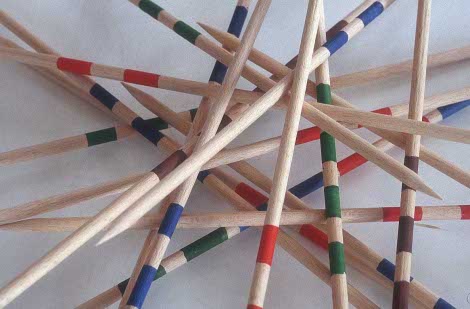
|
|
Mikado 1Ever played pick-up sticks? 3 One, two, Pick-up sticks are dropped on a table or floor to form a loose pile. Players take turns trying to remove one without disturbing others. A stick's color code indicates its value. The most valuable stick is often called "Mikado" (Emperor of Japan). 6 In real life there are many issues that concern us. Some now, others then. Circumstances change, priorities change. Years ago, I took some notes about various issues. Topping the list: Many sticks and others still—long sticks, short sticks, fat stick, thin sticks, straight sticks, crooked sticks. And yet to be mentioned: inadequate education and corrupted media. How, in real life, do we decide in wfleabyte.orghat order problems need to be tackled so as not to critically disturb the others. All the while keeping an eye on happenings elsewhere. 8 Mikado has its rules. Real-world Mikado vastly more. It also has cheaters. Every rule challenged by cheaters. "Money is the root of all evil," an old adage goes. Close, but no cigar; people are. 9 There was once an emperor who loved new, ever more beautiful attire, which he would show off to one and all. Hans Christian Andersen wrote about him—back in 1837, if you want to know. 10 Sorry, I am an old fogey and often get mixed up a bit. Adersen wrote many children's stories, mirrors for all to reflect in. From the downtrodden to the very fittest, who are not to be toyed with. Excellencies, Honorables, you know, and mere multibillionaires of course. 11 "The Emperor's new clothes" is also about two weavers who claimed to make clothes from the finest silk from China. And not only that. Their clothes would be invisible to anyone incompetent for the job he or she is supposed to do. Of course, when the Emperor heard about this he hired them instantly and gave them room to work and vast sums of money to buy those silks. Did he ever look forward to find those incompetent for their job! 12 Word got around about those magic clothes. When finally the day came for the Emperor to put on his new clothes, lighter even than a feather, the Emperor was shocked to not be able to see them. So were all his ministers, his cooks, and his generals. But, of course, they all kept quiet about that. Everybody praised the Emperor's new clothes, the beautiful colors, the patterns, the cut. Everybody agreed that the weavers deserved the highest order of the land and to be named Honorable Weavers of State. 13 Time came for the Emperor to put in a public appearance. Parading for his subjects in the Imperial Plaza, no one dared to say that the Emperor walked about in his underwear. Nobody wanted to be found unfit for the job they were supposed to do. Absolutely nobody; not until a school-aged girl shouted "But he isn't wearing anything at all!" Then others followed her lead, "The Emperor isn't wearing anything at all! 14 Loudest were the Emperor's Weftist minsters. His Warpists, however, denounced the Weftists' obvious incompetence. And the rest of the story has been going on till this very day and will go on in the time yet to come. Which leaves untouched our Mikado sticks. 15 I'm Hans Christian Andersen, Danny Kaye,
|
--
| top of page |
|

